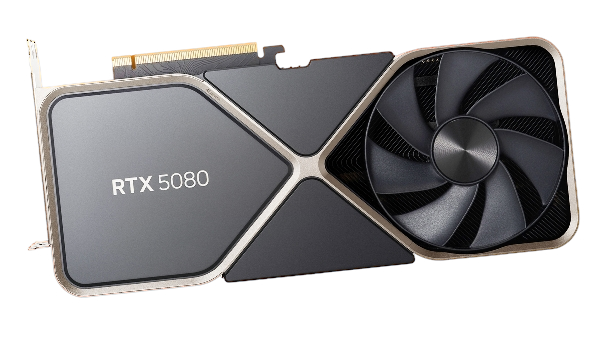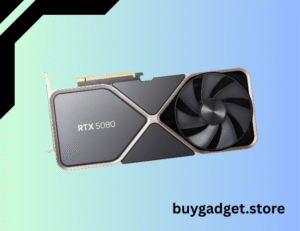Introduction:
NVIDIA’s GeForce RTX 5080 arrives as a stunning member of the RTX 50 series, promising gamers and creators a massive boost in performance, AI features, and realism. Built on the Blackwell architecture and equipped with cutting-edge technologies like DLSS 4, ray tracing cores, and ultra-fast GDDR7 memory, the RTX 5080 aims to set a new standard. But with high expectations comes high cost, both in price and power demand. In this blog, we’ll explore what makes the RTX 5080 extraordinary, where it might fall short, and whether it delivers value for those willing to invest.
Table of Contents
Blackwell Architecture & What It Brings
One of the headline upgrades with the RTX 5080 is NVIDIA’s Blackwell architecture. This is the foundation that enables better power efficiency, improved ray tracing, and more advanced AI capabilities. With Blackwell, features such as faster Tensor cores (fifth generation) and upgraded RT (ray tracing) cores (fourth generation) come into play. These changes make the RTX 5080 not just a raw performance card, but also a smarter one better handling things like neural rendering, AI-powered upscaling (DLSS 4), and complex lighting effects.
DLSS 4 and AI Enhancements: Smarter Visuals
DLSS 4 is a central feature that helps the RTX 5080 punch above its weight. This AI-powered technology allows games to run at higher resolutions with smoother frame rates, by intelligently reconstructing frames and reducing load on the GPU. Combined with features like Reflex 2, which improves responsiveness (especially for competitive gaming), the RTX 5080 aims to deliver both incredible visuals and fluid performance. For creators working with content, these AI enhancements can also speed up tasks like video rendering or graphical workloads.
Memory & Cooling Systems: Tackling Thermal Demands
To support its heavy performance, the RTX 5080 uses 16 GB of GDDR7 memory, 256-bit interface, and memory speeds around 30 Gbps (depending on model). That memory bandwidth helps in high resolution textures, large frame buffers, and AI tasks. However, all that power generates heat. Cards like the ASUS TUF and ROG Astral versions implement advanced cooling solutions quad-fan designs, vapor chambers, phase-change thermal pads to maintain stable temperatures even under load. Cooling quality becomes essential to unlocking the card’s full potential without throttling.
Features & Specifications Explained
Below is a table summarizing the core specifications of the RTX 5080. After the table, each major spec is explained in detail.
| Feature | Specification |
|---|---|
| Architecture | NVIDIA Blackwell (5th-Gen Tensor, 4th-Gen RT Cores) |
| CUDA Cores | 10,752 cores |
| Memory / Type | 16 GB GDDR7, 256-bit interface |
| Core / Boost Clock | 2.60-2.70 GHz on OC models |
| Power Connectors & PSU | Requires robust PSU (850W recommandation for OC versions) |
| Display Outputs | HDMI 2.1b ×2, DisplayPort 2.1b ×3 |
| Cooling Options | Dual/Quad fan, vapor chamber, larger heatsinks |
| Key Technologies | DLSS 4, AI rendering, Ray Tracing, Reflex 2 |
| TDP / Power Draw | Higher power draw than previous gen, particularly under OC |
Deep Dive: What These Specs Mean
Within that table lie some powerful promises. The large number of CUDA cores and upgraded clock speeds give the RTX 5080 serious muscle for demanding games at 4K, as well as for creative workloads like 3D rendering, video editing, and AI-assisted tasks. The shift to GDDR7 memory also adds bandwidth, helping reduce bottlenecks especially where high frame rates and high resolutions are concerned. Cooling becomes crucial; if the cooling solution is weak, the card may thermal-throttle, reducing real-world performance. These tech improvements make RTX 5080 more than just an iterative upgrade it’s a substantial leap.

Gaming Performance: 4K, Ray Tracing & Beyond
For gamers, the RTX 5080 aims to deliver excellent 4K gaming performance. When paired with the latest games that support ray tracing, the card uses its upgraded RT cores to deliver better lighting, shadows, and realistic reflections. DLSS 4 helps regain frame rate by boosting lower rendered frames. Competitive titles will also benefit from NVIDIA Reflex improvements, helping reduce latency. For users who want super-fluid gameplay on high refresh-rate monitors, RTX 5080 delivers a very compelling experience though pairing it with a strong CPU and fast RAM is necessary to avoid bottlenecks.
Creative & Professional Use Cases
It’s not just about gaming. Content creators, 3D artists, video editors, and developers all have reasons to get excited. With enhanced CUDA performance and AI features, tasks like rendering complex scenes, encoding 8K video, or working with AI models become smoother. NVIDIA’s Studio drivers and tools also support creators, helping stability and optimization. For those whose workflows demand heavy graphics manipulation or AI assistance, the RTX 5080 could reduce workflow times and expand what’s possible on a single workstation.
Power, Efficiency & Connectivity
One area where the RTX 5080 may surprise: despite its high performance, the Blackwell architecture includes efficiency improvements. These gains mean somewhat better performance per watt, especially when not overclocked. Connectivity has also been updated to support modern standards: HDMI 2.1b, DisplayPort 2.1b, PCIe 5.0. Ensure your power supply (PSU) is strong enough custom models often suggest 850W or higher for stability under load. Without good power delivery and proper cooling, users won’t unlock the card’s full potential.
Positives: What Makes RTX 5080 Truly Impressive
- Massive performance uplift over prior generation for ray tracing and AI workloads.
- Modern memory (GDDR7) and fast interface delivering high bandwidth.
- Strong support for DLSS 4 and AI enhancements making visual fidelity and FPS more balanced.
- Premium cooling solutions available keep the card stable under load.
- Future-ready connectivity and architecture ensure longevity.
These strengths make the RTX 5080 a powerhouse for those who want top-tier visuals and strong creator capabilities.
Negatives: What to Consider
- High Price Tag: It is a premium component expect steep costs, especially for custom OC versions.
- Power & Cooling Requirements: Needs a strong PSU and good airflow.
- Size & Fit Issues: Some custom cards (quad-fan, bulky heatsinks) demand large PC cases.
- Marginal Gains Without DLSS/AI Enabled: Some users will see only modest improvements in raw rasterization if the game doesn’t use AI features.
- Competition and Alternatives: If you don’t need absolute highest settings or ray tracing, slightly cheaper cards or last-gen high end may offer better value.
Who Is the RTX 5080 For?
If you are a serious gamer aiming for 4K with ray tracing, a creator working in 3D or video editing, or someone interested in AI-powered graphics, the RTX 5080 makes a lot of sense. It’s for users who demand the very best and are willing to invest in supporting hardware (cooling, PSU, case space). If you mostly play esports titles or 1080p/1440p gaming, or your work isn’t graphics-intensive, then the RTX 5080 might be more than you need.
Price vs Value: Is It Worth It?
Whether the RTX 5080 is worth its price depends largely on how much you use its advanced features. If you take advantage of ray tracing, AI upscaling, DLSS 4, and high resolution/refresh gaming, the value is strong. But if much of your gaming or work stays within less demanding bounds, the extra cost may not justify the incremental gains. Also, the cost of a good power supply, cooling, and possibly a large case add to total build price.
Future Outlook: Will It Age Well
With its modern architecture, updated memory standard, and strong feature set, the RTX 5080 looks built for longevity. The reliance on AI and DLSS means that as games and applications evolve, this card may continue to shine. However, its best performance depends on support from developers ray tracing and AI need software backing. As well, supply of updates in drivers and firmware will matter. If maintained, the RTX 5080 could remain relevant for several years.
Conclusion:
The NVIDIA GeForce RTX 5080 is undeniably a powerful leap forward in GPU technology. It offers remarkable enhancements in ray tracing, AI rendering, and overall graphics performance. For gamers and content creators aiming for the highest fidelity, it’s a compelling choice. But its power doesn’t come cheap, nor is it trivial to integraterequirements for cooling, power, and case space are real. In the end, whether the RTX 5080 is a bold investment well made or a pricey step beyond necessity comes down to your personal needs and budget. If you’re chasing cutting-edge visuals and future-proof build, this card delivers. If not, some of its glory might be more than necessary.
